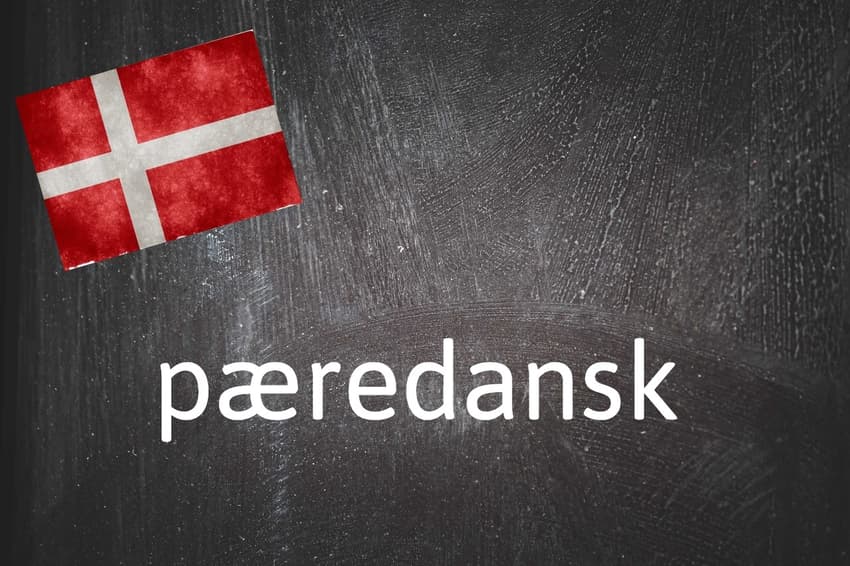Danish word of the day: Pæredansk

Photo by Francesco Ungaro on Unsplash and Nicolas Raymond/FlickR
Today's word of the day is as Danish as rugbrød, candlelit rooms and disappointing weather.
What is pæredansk?
Pæredansk means to be typically or thoroughly Danish. It appears to be a compound of two words: pære which means pear (and can also mean light bulb), and dansk, Danish.
According to Dansk Sprognævn, the regulatory body of the Danish language, the origins of the word in fact have nothing to do with pears the fruit. The prefix pære in pæredansk is not in fact a noun but is a corruption of the Latin pure, which can also be found in English where it has the same meaning as in the older language: to be unmixed or consist entirely of.
As such, pære in pæredansk functions as a reinforcing adjective. Comparable prefixes in Danish include ærke- ("arch-") and ægte- ("genuine"). Although pære- is uncommon, it is found in at least one other Danish word, pærelet ("very easy").
Why do I need to know pæredansk?
Denmark is a multicultural society and it's not uncommon to hear people whose heritage does not extend outside of Denmark use the word to be inclusive of elements of society or culture that have come from other parts of the world. "I'm pæredansk, but I'd much rather eat pizza than smørrebrød," for example.
Although its meaning can be translated to "purely Danish", pæredansk does not, in my experience, seem to be a word used by politicians who oppose immigration or multiculturalism. They would reject the idea that a national identity can change and are therefore likely to see pæredansk and dansk as being the same thing, and therefore only use the latter to refer to Danish heritage.
Viewed through this lens, it seems that pæredansk is a recognition, rather than rejection, of Denmark's multiculturalism. However, this is just how I (a European non-Dane who lives in Denmark) have personally experienced and interpreted its use, and I'd be happy to hear from anyone who sees this differently.
It's worth remembering that pæredansk doesn't have to have political or racial connotations. You can say rainy summer weather, toasted rye bread and lighting candles at the dinner table are all pæredansk because they are very typical parts of Danish life.
Examples
Jeg ser pæredansk ud med mit lyse hår og blå øjne, men jeg kommer faktisk fra Skotland.
I look like a typical Dane with my blonde hair and blue eyes, but I'm actually from Scotland.
Nogle politikerne mener, at jobansøgninger skal gøres anonyme, fordi der har været meldinger om at ikke-pæredanske navne bliver sorteret fra.
Some politicians think that job applications should be anonymous because there have been reports of non-typical Danish names being rejected.
Comments
See Also
What is pæredansk?
Pæredansk means to be typically or thoroughly Danish. It appears to be a compound of two words: pære which means pear (and can also mean light bulb), and dansk, Danish.
According to Dansk Sprognævn, the regulatory body of the Danish language, the origins of the word in fact have nothing to do with pears the fruit. The prefix pære in pæredansk is not in fact a noun but is a corruption of the Latin pure, which can also be found in English where it has the same meaning as in the older language: to be unmixed or consist entirely of.
As such, pære in pæredansk functions as a reinforcing adjective. Comparable prefixes in Danish include ærke- ("arch-") and ægte- ("genuine"). Although pære- is uncommon, it is found in at least one other Danish word, pærelet ("very easy").
Why do I need to know pæredansk?
Denmark is a multicultural society and it's not uncommon to hear people whose heritage does not extend outside of Denmark use the word to be inclusive of elements of society or culture that have come from other parts of the world. "I'm pæredansk, but I'd much rather eat pizza than smørrebrød," for example.
Although its meaning can be translated to "purely Danish", pæredansk does not, in my experience, seem to be a word used by politicians who oppose immigration or multiculturalism. They would reject the idea that a national identity can change and are therefore likely to see pæredansk and dansk as being the same thing, and therefore only use the latter to refer to Danish heritage.
Viewed through this lens, it seems that pæredansk is a recognition, rather than rejection, of Denmark's multiculturalism. However, this is just how I (a European non-Dane who lives in Denmark) have personally experienced and interpreted its use, and I'd be happy to hear from anyone who sees this differently.
It's worth remembering that pæredansk doesn't have to have political or racial connotations. You can say rainy summer weather, toasted rye bread and lighting candles at the dinner table are all pæredansk because they are very typical parts of Danish life.
Examples
Jeg ser pæredansk ud med mit lyse hår og blå øjne, men jeg kommer faktisk fra Skotland.
I look like a typical Dane with my blonde hair and blue eyes, but I'm actually from Scotland.
Nogle politikerne mener, at jobansøgninger skal gøres anonyme, fordi der har været meldinger om at ikke-pæredanske navne bliver sorteret fra.
Some politicians think that job applications should be anonymous because there have been reports of non-typical Danish names being rejected.
Join the conversation in our comments section below. Share your own views and experience and if you have a question or suggestion for our journalists then email us at [email protected].
Please keep comments civil, constructive and on topic – and make sure to read our terms of use before getting involved.
Please log in here to leave a comment.